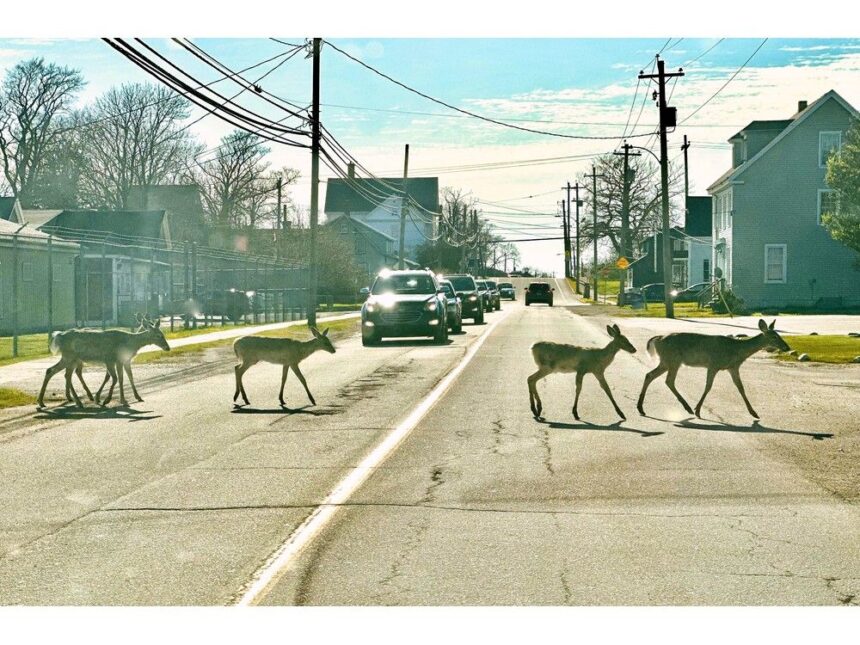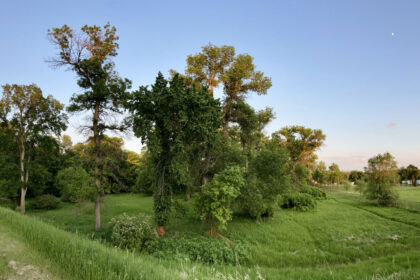An update from the Town of Yarmouth Deer Management Working GroupPublished Aug 27, 20256 minute readTraffic is stopped on Yarmouth’s Parade Street as deer cross the street. TINA COMEAUArticle contentAfter years of study and exploring various options, the Town of Yarmouth’s Deer Management Working Group will be seeking permission from the province’s Department of Natural Resources (DNR) to conduct a controlled deer cull within town limits during the upcoming hunting season.THIS CONTENT IS RESERVED FOR SUBSCRIBERS ONLY.Subscribe now to access this story and more:Unlimited access to the website and appExclusive access to premium content, newsletters and podcastsFull access to the e-Edition app, an electronic replica of the print edition that you can share, download and comment onEnjoy insights and behind-the-scenes analysis from our award-winning journalistsSupport local journalists and the next generation of journalistsSUBSCRIBE TO UNLOCK MORE ARTICLES.Subscribe or sign in to your account to continue your reading experience.Unlimited access to the website and appExclusive access to premium content, newsletters and podcastsFull access to the e-Edition app, an electronic replica of the print edition that you can share, download and comment onEnjoy insights and behind-the-scenes analysis from our award-winning journalistsSupport local journalists and the next generation of journalistsRegister to unlock more articles.Create an account or sign in to continue your reading experience.Access additional stories every monthShare your thoughts and join the conversation in our commenting communityGet email updates from your favourite authorsSign In or Create an AccountorArticle contentFor years, the town has contemplated how to address the ever-growing deer population within the town. It said in August that a proposal for a deer cull was being fine-tuned for submission to DNR.Article contentArticle contentArticle content“The group’s first draft proposal, submitted in May of 2025, was deemed to be lacking in detail,” the town said. “The requested details are now being added, and a final proposal will be submitted.”Article contentThe deer population within the town is seen as problematic for many reasons. The town says the presence of deer on streets and in traffic poses a safety hazard. Deer eat and destroy people’s gardens and landscaping. Deer also carry ticks, which can cause the transmission of Lyme disease.Article content Photo taken on Elm Street in Yarmouth of many deer outside a property. When a vehicle attempted minutes later to pull into the driveway, the deer would not move out of the way. TINA COMEAU Photo by Tina Comeau /.Article contentCOMMUNICATING WITH THE PUBLICArticle contentThe town is making residents aware of its plans through social media posts, its websites, through mainstream media, and by sending information out to households with the tax bills.Article content“As a resident, we trust you can understand the complexity of this issue,” writes the town to its residents. “In addition, we also recognize there are some who oppose any method which harms the animals, and their opinion must also be respected.”Article contentArticle contentThe town admits reducing the deer population will not eliminate the existence of the black legged tick and the spread of Lyme disease, as there are also other tick hosts, including birds and white-footed mice.Article contentArticle contentThe town’s deer problem is also not unique. It’s an issue prevalent throughout the province and in North America.Article content“Nova Scotia, with its relatively moderate climate, ample food sources, lack of predators, and a decline in the number of seasonal hunters, provides ideal conditions for the white tail deer, which are not native to this province,” says the town. “Yarmouth, unfortunately, has an even more suitable climate (Zone 6B) for deer habitat.”Article content The Town of Yarmouth has been exploring what can be done to address the growing urban deer population within the town. TINA COMEAU Photo by Tina Comeau /TINA COMEAUArticle contentWHAT’S BEEN DONE TO DATEArticle contentThe town offers this list highlighting some of the work that’s taken place in recent years regarding the deer situation.Article content• Significant research has been conducted to explore all potential strategies to control the urban deer population. Options explored have included: tranquilize and relocate; euthanize; trap/neuter/release; use of contraceptives; deterrence methods; limiting preferred forage; a controlled cull; and more.Article content• A public survey gauged the extent of the deer population problem, the issues it creates for residents, and public sentiment around forming a population management strategy.Article content• A public information session was hosted by the town and DNR, which attracted approximately 100 concerned citizens. The session allowed for one-on-one conversations to discuss the issue and possible management strategies.Article contentArticle content• Several invitations have been honoured for a working group representative to attend meetings of concerned groups to provide information and updates about the town’s deer management process.Article content Through a window of a vehicle, numerous deer are seen on Th’YARC property on Parade Street in Yarmouth after crossing the street amongst busy traffic. TINA COMEAUArticle content• A bylaw prohibiting the feeding of wild animals was enacted by the Town of Yarmouth with potential fines of up to $1,000.Article content• Signage, social media posts, news articles, and one-on-one engagement with the public have been utilized to glean information and provide status of our initiatives.Article content• In accordance with DNR requirements to provide statistical data indicating the size of the urban deer population and the trend over a period of three years (and with the knowledge that anecdotal information was not considered reliable), the town engaged a consultant to conduct a Pellet Group Inventory (PGI) in 2024 and 2025.Article content• Volunteers also conducted a roadside count over a 14-day period, which entailed traveling a prescribed route each day for one hour after sunrise and one hour before sunset, documenting sightings and, where possible, the age and sex of the animals.Article contentArticle content• The working group has also gathered data regarding conflict with deer, such as vehicle collisions, property damage, effectiveness of deterrence methods, etc.Article content• Qualified hunters for a cull are also being identified.Article content A group of deer approaches a home in the south part of the Town of Yarmouth. CONTRIBUTEDArticle contentFOOD BANK DONATIONSArticle contentIf a cull takes place, the working group has confirmed with that the local food bank will accept meat that has been properly processed and wrapped, for distribution to those in need.Article contentAn outlet for hides has also been established for use in the creation of ceremonial drums.Article contentThe compost facility has indicated it is prepared to accept the non-edible remains and jaw bones will be delivered to the Department for research purposes.Article content In the Town of Yarmouth deer are commonplace on sidewalks and in the streets and in people’s yards. These deer were on Elm Street in the spring of 2024. Not seen in the photo is the other five deer that were with them. TINA COMEAU Photo by Tina Comeau /.Article contentREQUIRED CONDITIONSArticle content“Our work continues, and the group is focused on finalizing the proposal to DNR. To receive authorization for a ‘Nuisance Wildlife Permit’ several conditions must be met,” the town says.Article contentThese conditions include:Article content• Permission of property owners where the population control will be conducted.Article content• Evidence that enough constituents have raised concerns.Article content• Reasonable prevention methods have been employed to mitigate the harm caused by the animals.Article content A deer takes its time crossing a residential street in the north end of the Town of Yarmouth. TINA COMEAUArticle content• That the Town of Yarmouth will not rely solely on population control but will also include prevention and multiple management methods, which are humane and supportive of deer health and welfare; supportive of sustainable deer management; and are compliant with all Provincial Acts and Regulations.Article content• The town must have conducted at least one deer population survey using standard scientific methods (originally three years). The town has completed two.Article content• The proposal must include details on how the town other prevention measures (education, fencing, plant selection) and why those methods, on their own, are considered insufficient.Article contentArticle content• A detailed plan of how the cull will be conducted must be submitted.Article contentTHE CHALLENGES OF LIMITED SPACEArticle contentThe town says that planning a cull within town limits is the most difficult hurdle it has to overcome.Article content“We are frequently reminded that the Town of Truro has conducted hunts for several years. However, comparison of the municipal units will reveal distinct differences,” the town says. “The Town of Yarmouth (population 7,000) is approximately 11 square kilometres, while Truro (population 13,000) covers more than 37 square kilometres.”Article content A map showing the limited areas in the Town of Yarmouth, in which a deer cull could take place. Areas contained in the various coloured buffer zones are off-limits for any type of hunting activity. These buffers are around schools, residences, businesses, the golf course, etc. TOWN OF YARMOUTH MAPArticle contentThe town says when conducting a hunt, specific distances must be maintained from any residences, schools, and businesses. You must be at least 804 metres from any school and 182 metres from any business or residence.Article contentDNR also stipulates that the town must provide details regarding the precise locations of blinds, bait stations, shooting lanes, and access routes. The department must be satisfied with all of these.Article contentArticle content“Given the size of our town, hunting location options are very limited and for the most part, may not have an impact on the number of animals that live within town boundaries,” the town states. “We are in discussion on methods of enticing the urban herd to locations that may be approved for a controlled hunt to ensure some success.”Article contentFinally, the town says it must indicate whether it would plan to continue the hunt in subsequent years and how many animals would be targeted at each site.Article contentTHE CHARTArticle contentPeople can view a chart indicating the distances that must be maintained from any residences, schools, and businesses, as well as a map of the town indicating the areas in which the use of any weapon is prohibited. People can view the chart on the town’s Get Involved Yarmouth website where information about the deer strategy and working group work is posted. People may also request a paper copy at the Town Hall, located at 400 Main St.Article content This chart from the Town of Yarmouth shows the minimum hunting setbacks that are required where people live, work and play. The references marked (c) indicate that the owner or occupier of a dwelling or a person permitted by them who is licensed may hunt within these distances if point of discharges is not within the prescribed distance of other dwelling or business and other areas.Article content
Town of Yarmouth seeking permission from province for deer cull











